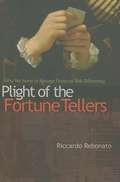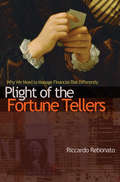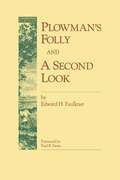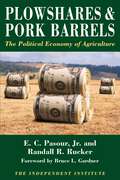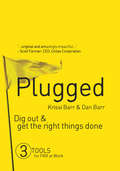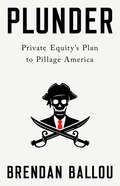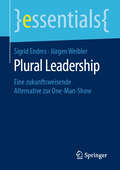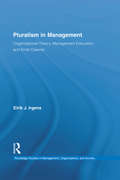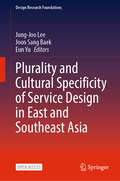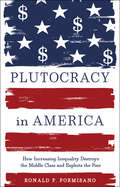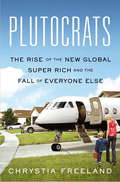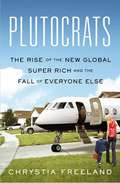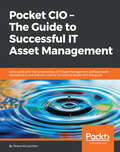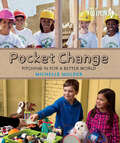- Table View
- List View
Plenty of Nothing: The Downsizing of the American Dream and the Case for Structural Keynesianism
by Thomas I. PalleyBusiness papers today are in a triumphant mood, buoyed by a conviction that the economic stagnation of the last quarter century has vanished in favor of a new age of robust growth. But if we are doing so well, many ask, why does it feel like we are working harder for less? Why, despite economic growth, does inequality between rich and poor keep rising? In this wide-ranging and provocative book, Thomas Palley pulls together many threads of "new liberal" economic thought to offer detailed answers to these pressing questions. And he proposes a new economic model--structural Keynesianism--that he argues would return America to sustainable, fairly shared prosperity. The key, he writes, is to abandon the myth of a natural competitive economy, which has justified unleashing capital and attacking unions. This has resulted in an economy dominated by business. Palley's book, which began as a cover article for The Atlantic Monthly in 1996, challenges the economic orthodoxies of the political right and center, popularized by such economists as Milton Friedman and Paul Krugman. He marshals a powerful array of economic facts and arguments to show that the interests of working families have gradually been sacrificed to those of corporations. Expanding on traditional Keynesian economics, he argues that, although capitalism is the most productive system ever devised, it also tends to generate deep economic inequalities and encourage the pursuit of profit at the expense of all else. He challenges fatalists who say we can do nothing about this--that economic insecurity and stagnant wages are the inevitable results of irresistible globalization. Palley argues that capitalism comes in a range of forms and that government can and should shape it from a "mean street" system into a "main street" system through monetary, fiscal, trade, and regulatory policies that promote widespread prosperity. Plenty of Nothing offers a compelling alternative to conventional economic wisdom. The book is clearly and powerfully written and will provoke debate among economists and the general public about the most stubborn problems in the American economy.
Plight of the Fortune Tellers: Why We Need to Manage Financial Risk Differently
by Riccardo RebonatoToday's top financial-risk professionals have come to rely on ever-more sophisticated mathematics in their attempts to come to grips with financial risk. But this excessive reliance on quantitative precision is misleading--and it puts us all at risk. This is the case that Riccardo Rebonato makes inPlight of the Fortune Tellers--and coming from someone who is both an experienced market professional and an academic, this heresy is worth listening to. Rebonato forcefully argues that we must restore genuine decision making to our financial planning, and he shows us how to do it using probability, experimental psychology, and decision theory. This is the only way to effectively manage financial risk in a manner congruent with how human beings actually react to chance. Rebonato challenges us to rethink the standard wisdom about probability in financial-risk management. Risk managers have become obsessed with measuring risk and believe that these quantitative results bythemselvescan guide sound financial choices--but they can't. In this book, Rebonato offers a radical yet surprisingly commonsense solution, one that seeks to remind us that managing risk comes down to real people making decisions under uncertainty. Plight of the Fortune Tellersis not only a book for the decision makers of Wall Street, it's a must-read for anyone concerned about how today's financial markets are run. The stakes have never been higher--can you risk it?
Plight of the Fortune Tellers: Why We Need to Manage Financial Risk Differently
by Riccardo RebonatoToday's top financial professionals have come to rely on ever-more sophisticated mathematics in their attempts to come to grips with financial risk. But this excessive reliance on quantitative precision is misleading--and puts everyone at risk. In Plight of the Fortune Tellers, Riccardo Rebonato forcefully argues that we must restore genuine decision making to our financial planning. Presenting a financial model that uses probability, experimental psychology, and decision theory, Rebonato challenges us to rethink the standard wisdom about risk management. He offers a radical yet surprisingly commonsense solution: managing risk comes down to real people making decisions under uncertainty. Plight of the Fortune Tellers is a must-read for anyone concerned about how today's financial markets are run. In a new preface, Rebonato explains how the ideas presented in this book fit into the context of the global financial crisis that followed its original publication. He argues that risk managers are still stuck in a probabilistic rut, and need to engage with the structural causes of real events.
Pliny's Roman Economy: Natural History, Innovation, and Growth (The Princeton Economic History of the Western World #113)
by Richard SallerThe first comprehensive study of Pliny the Elder’s economic thought—and its implications for understanding the Roman Empire’s constrained innovation and economic growthThe elder Pliny’s Natural History (77 CE), an astonishing compilation of 20,000 “things worth knowing,” was avowedly intended to be a repository of ancient Mediterranean knowledge for the use of craftsmen and farmers, but this 37-book, 400,000-word work was too expensive, unwieldy, and impractically organized to be of utilitarian value. Yet, as Richard Saller shows, the Natural History offers more insights into Roman ideas about economic growth than any other ancient source. Pliny’s Roman Economy is the first comprehensive study of Pliny’s economic thought and its implications for understanding the economy of the Roman Empire.As Saller reveals, Pliny sometimes anticipates modern economic theory, while at other times his ideas suggest why Rome produced very few major inventions that resulted in sustained economic growth. On one hand, Pliny believed that new knowledge came by accident or divine intervention, not by human initiative; research and development was a foreign concept. When he lists 136 great inventions, they are mostly prehistoric and don’t include a single one from Rome—offering a commentary on Roman innovation and displaying a reverence for the past that contrasts with the attitudes of the eighteenth-century encyclopedists credited with contributing to the Industrial Revolution. On the other hand, Pliny shrewdly recognized that Rome’s lack of competition from other states suppressed incentives for innovation. Pliny’s understanding should be noted because, as Saller shows, recent efforts to use scientific evidence about the ancient climate to measure the Roman economy are flawed.By exploring Pliny’s ideas about discovery, innovation, and growth, Pliny’s Roman Economy makes an important new contribution to the ongoing debate about economic growth in ancient Rome.
Plowman's Folly and A Second Look
by Edward H. Faulkner Edward H. University of Oklahoma Press Paul B. SearsAs the ruinous Dust Bowl settled in the early 1940s, agronomist Edward Faulkner dropped what Nature magazine termed "an agricultural bombshell" when he blamed the then universally used moldboard plow for disastrous pillage of the soil. Faulkner's assault on the orthodoxy of his day will stimulate today's farmers to seek out fresh solutions to the problems that plague modern American agriculture. Plowman's Folly is bound together here with its companion volume A Second Look.
Plowshares & Pork Barrels: The Political Economy of Agriculture
by E. C. Pasour Jr. Randall R. RuckerPlowshares & Pork Barrels provides the historical and economic context necessary to make sense of U.S. agricultural policy and examines possible market-based alternatives that could benefit consumers and ensure the advancement of American agriculture in an increasingly interdependent global economy.Established in 1860, the U.S. Department of Agriculture has grown without cease and is now the most entrenched of all federal agencies. The Farm Bills signed by Presidents Bill Clinton in 1996 and George W. Bush in 2002 only served to further expand this byzantine system. Economists are nearly unanimous in their denunciation of this wasteful and pernicious web of politics. Subsidies for not growing crops are so notorious that they have been the object of biting political satire since their introduction in the 1930s. However, few books have critically analyzed government farm programs in their entirety like Plowshares & Pork Barrels.
Plowshares into Swords: Weaponized Knowledge, Liberal Order, and the League of Nations
by David EkbladhAn in-depth look at how the ideas formulated by the interwar League of Nations shaped American thinking on the modern global order. In Plowshares into Swords, David Ekbladh recaptures the power of knowledge and information developed between World War I and World War II by an international society of institutions and individuals committed to liberal international order and given focus by the League of Nations in Geneva. That information and analysis revolutionized critical debates in a world in crisis. In doing so, Ekbladh transforms conventional understandings of the United States’ postwar hegemony, showing that important elements of it were profoundly influenced by ideas that emerged from international exchanges. The League’s work was one part of a larger transnational movement that included the United States and which saw the emergence of concepts like national income, gross domestic product, and other attempts to define and improve the standards of living, as well as new approaches to old questions about the role of government. Forged as tools for peace these ideas were beaten into weapons as World War II threatened. Ekbladh recounts how, though the US had never been a member of the organization, vital parts of the League were rescued after the fall of France in 1940 and given asylum at the Institute for Advanced Study in Princeton. However, this presence in the US is just one reason its already well-regarded economic analyses and example were readily mobilized by influential American and international figures for an Allied “war of ideas,” plans for a postwar world, and even blueprints for the new United Nations. How did this body of information become so valuable? As Ekbladh makes clear, the answer is that information and analysis themselves became crucial currencies in global affairs: to sustain a modern, liberal global order, a steady stream of information about economics, politics, and society was, and remains, indispensable.
Plowshares into Swords: Weaponized Knowledge, Liberal Order, and the League of Nations
by David EkbladhAn in-depth look at how the ideas formulated by the interwar League of Nations shaped American thinking on the modern global order. In Plowshares into Swords, David Ekbladh recaptures the power of knowledge and information developed between World War I and World War II by an international society of institutions and individuals committed to liberal international order and given focus by the League of Nations in Geneva. That information and analysis revolutionized critical debates in a world in crisis. In doing so, Ekbladh transforms conventional understandings of the United States’ postwar hegemony, showing that important elements of it were profoundly influenced by ideas that emerged from international exchanges. The League’s work was one part of a larger transnational movement that included the United States and which saw the emergence of concepts like national income, gross domestic product, and other attempts to define and improve the standards of living, as well as new approaches to old questions about the role of government. Forged as tools for peace these ideas were beaten into weapons as World War II threatened. Ekbladh recounts how, though the US had never been a member of the organization, vital parts of the League were rescued after the fall of France in 1940 and given asylum at the Institute for Advanced Study in Princeton. However, this presence in the US is just one reason its already well-regarded economic analyses and example were readily mobilized by influential American and international figures for an Allied “war of ideas,” plans for a postwar world, and even blueprints for the new United Nations. How did this body of information become so valuable? As Ekbladh makes clear, the answer is that information and analysis themselves became crucial currencies in global affairs: to sustain a modern, liberal global order, a steady stream of information about economics, politics, and society was, and remains, indispensable.
Plugged
by Paul Hersey Krissi Barr Dan BarrPart business book, part golf novel, Plugged resonates long afterwards and provides real world lessons that apply to the home, the office or the golf course. Chet McGill, the dedicated vice president of sales at AlphaMax Manufacturing, is under fire - Trident, their biggest client, is being pursued, aggressively, by a new competitor. At the same time, Chet is feeling off-balance as he preps for a golf tournament in which he's partnered with Reggie Ward, Trident's vice president of operations. Faced with big problems and with all eyes on him, Chet learns to get back to what's important to his company, his clients, and himself. Pluggedteaches readers to "shoot for PAR," a simple, proven method to achieve success in just three useful steps - prioritize, adapt, and be responsible. In the spirit of Who Moved My Cheese?, Krissi and Dan Barr offer a simple parable that is engaging, engrossing and empowering.
Pluggin In the Consumer: The Adoption of Electrically Powered Vehicles in the U.S.
by Elie Ofek Polly Ross RibattHow will U.S. consumers respond to the proliferation of alternative-fuel vehicles, such as cars powered partially or completely by electricity, in the coming decade? After a century in which fossil-fuel-powered vehicles dominated the market, it appeared consumers would have an unprecedented level of choice as to the type of car they purchased and drove. Automakers were introducing various models that used electricity for power, and other power sources, such as fuel cells, were also seeing increased attention. Some observers believed the time was ripe for widespread adoption of these new vehicles: consumers and policymakers were increasingly concerned about the fallout of U.S. dependence on fossil-fuel-powered cars-namely, adverse environmental impacts and reliance on foreign sources of oil, plus the fluctuating price of gasoline-and innovative infrastructure technology was being developed to support electric-powered cars. Despite these promising developments, it remained unclear whether consumers were ready to switch to alternative-fuel vehicles on a large scale. Would they be willing to make the lifestyle trade-offs required for grid-dependent vehicles? How should policymakers intervene, if at all, to encourage adoption, and what marketing activities and incentives might firms employ to stimulate demand?
Plunder: Private Equity's Plan to Pillage America
by Brendan BallouThe authoritative exposé of private equity: what it is, how it kills businesses and jobs, how the government helps, and how we stop it Private equity surrounds us. Firms like Blackstone, Carlyle, and KKR are among the largest employers in America and hold assets that rival those of small countries. Yet few understand what these firms are or how they work. In Plunder, Brendan Ballou explains how private equity has reshaped American business by raising prices, reducing quality, cutting jobs, and shifting resources from productive to unproductive parts of the economy. Ballou vividly illustrates how many private equity firms buy up retailers, medical practices, prison services, nursing-home chains, and mobile-home parks, among other businesses, using little of their own money to do it and avoiding debt and liability for their actions. Forced to take on huge debts and pay extractive fees, companies purchased by private equity firms are often left bankrupt, or shells of their former selves, with consequences to communities that long depended on them. Perhaps most startling is Ballou&’s insight into how this is happening with the active support of various arms of the government. But, as Ballou reveals in an agenda for reining in the industry, private equity can be stopped from wreaking further havoc.
Plundering the North: A History of Settler Colonialism, Corporate Welfare, and Food Insecurity
by Kristin Burnett Travis HayThe manufacturing of a chronic food crisis Food insecurity in the North is one of Canada’s most shameful public health and human rights crises. In Plundering the North, Kristin Burnett and Travis Hay examine the disturbing mechanics behind the origins of this crisis: state and corporate intervention in northern Indigenous foodways. Despite claims to the contrary by governments, the Hudson’s Bay Company (HBC), and the contemporary North West Company (NWC), the exorbitant cost of food in the North is neither a naturally occurring phenomenon nor the result of free-market forces. Rather, inflated food prices are the direct result of government policies and corporate monopolies. Using food as a lens to track the institutional presence of the Canadian state in the North, Burnett and Hay chart the social, economic, and political changes that have taken place in northern Ontario since the 1950s. They explore the roles of state food policy and the HBC and NWC in setting up, perpetuating, and profiting from food insecurity while undermining Indigenous food sovereignties and self-determination. Plundering the North provides fresh insight into Canada’s settler colonial project by re-evaluating northern food policy and laying bare the governmental and corporate processes behind the chronic food insecurity experienced by northern Indigenous communities.
Plural Leadership: Eine zukunftsweisende Alternative zur One-Man-Show (essentials)
by Sigrid Endres Jürgen WeiblerTechnologiegetriebene Geschäftsmodelle und veränderte Erwartungen an die Arbeit (New Work) verlangen nach Alternativen zu traditionellen Führungsformen. Dieses essential liefert hierzu innovatives Führungswissen und konzentriert sich dabei auf Plural Leadership. Neben Ausführungen zu Co-Leadership, Führungsdual und Verteilter Führung wird Shared Leadership als besonders elaborierte Form von Plural Leadership vertiefend illustriert. Die Autoren analysieren kompakt und kritisch, was Plural Leadership für die Praxis bringt und wie es sinnvoll umgesetzt werden kann.
Pluralism in Management: Organizational Theory, Management Education, and Ernst Cassirer (Routledge Studies in Management, Organizations and Society)
by Eirik IrgensAnalytic philosophy has come to dominate organizational theory and management education, despite criticism from several notable scholars. The European continental philosophical tradition, on the other hand, is seen by some as a counterpoint to US- and UK-dominated functionalistic organizational theories. These two very different schools of thought are now largely practiced in isolation from one another. Late nineteenth and early twentieth century philosopher Ernst Cassirer served as a mediating force and facilitated a fruitful dialogue between the two schools until he was forced to leave Germany when the Nazi party came to power. In Pluralism in Management, author Eirik J. Irgens utilizes Ernst Cassirer’s pluralistic philosophy in order to investigate how different but connected forms of knowing, including art, myth, religion, science, and history may help us become better organizational scholars and management educators. With a special emphasis on the complementary qualities of art and science, Irgens builds on Cassirer to discuss how art and science represent two different but complementary channels to reality, in contrast with each other but not in conflict or contradiction, and the challenge of developing "two-eyed" managers. Revitalizing Cassirer’s almost forgotten philosophy, the book illustrates the value of philosophical application to organizational study, and the need for bringing together the best of the humanities and the science based management traditions in order to improve management education.
Pluralistic Economics and Its History
by Ajit Sinha Alex M. ThomasThis volume is a history of economics – as it was interpreted, discussed and established as a discipline – in the 20th century. It highlights the pluralism of the discipline and brings together leading voices in the field who reflect on their lifelong work. The chapters draw on a host of traditions of economic thought, including pre-classical, classical, Marxian, neoclassical, Sraffian, post-Keynesian, Cantabrigian and institutionalist traditions in economics. Further, the volume also looks at the history of economics in India and its evolution as a discipline since the country’s independence. This book will appeal to students, researchers and teachers of economics and intellectual history, as well as to the interested general reader.
Plurality and Cultural Specificity of Service Design in East and Southeast Asia (Design Research Foundations)
by Joon Sang Baek Jung-Joo Lee Eun YuThis open-access book expounds on how service design has been adopted and practiced in Asia, and how it has impacted especially the East and Southeast Asian countries. As service design is a socio-technical practice that is co-produced in context, the contributors focus on how service design has been applied and how it has evolved heterogeneously by interacting with the cultural and social dimensions of Asian countries. As the application domains of service design vary, this book covers adoptions and practices in different areas: Asian governments, the civic and grassroots sectors, and business transformation. The contextual framing of the chapters is ultimately synthesized and analyzed in the concluding Discussion chapter of the book. This chapter takes into consideration the history and objects of service design, the interactions between research and practice, methodologies, and comparisons to practices in the Western World. This book appeals to students, researchers, and professionals in the field.
Plutocracy in America: How Increasing Inequality Destroys the Middle Class and Exploits the Poor
by Ronald P. FormisanoA hard-hitting analysis of how the disparity between wealth and poverty undermines the common good.The growing gap between the most affluent Americans and the rest of society is changing the country into one defined—more than almost any other developed nation—by exceptional inequality of income, wealth, and opportunity. This book reveals that an infrastructure of inequality, both open and hidden, obstructs the great majority in pursuing happiness, living healthy lives, and exercising basic rights. A government dominated by finance, corporate interests, and the wealthy has undermined democracy, stunted social mobility, and changed the character of the nation. In this tough-minded dissection of the gulf between the super-rich and the working and middle classes, Ronald P. Formisano explores how the dramatic rise of income inequality over the past four decades has transformed America from a land of democratic promise into one of diminished opportunity. Since the 1970s, government policies have contributed to the flow of wealth to the top income strata. The United States now is more a plutocracy than a democracy. Formisano surveys the widening circle of inequality’s effects, the exploitation of the poor and the middle class, and the new ways that predators take money out of Americans’ pockets while passive federal and state governments stand by. This data-driven book offers insight into the fallacy of widespread opportunity, the fate of the middle class, and the mechanisms that perpetuate income disparity.
Plutocrats United
by Richard L. HasenCampaign financing is one of today's most divisive political issues. The left asserts that the electoral process is rife with corruption. The right protests that the real aim of campaign limits is to suppress political activity and protect incumbents. Meanwhile, money flows freely on both sides. In "Plutocrats United, "Richard Hasen argues that both left and right avoid the key issue of the new Citizens United era: balancing political inequality with free speech. The Supreme Court has long held that corruption and its appearance are the only reasons to constitutionally restrict campaign funds. Progressives often agree but have a much broader view of corruption. Hasen argues for a new focus and way forward: if the government is to ensure robust political debate, the Supreme Court should allow limits on money in politics to prevent those with great economic power from distorting the political process. "
Plutocrats: The New Golden Age
by Chrystia FreelandIn the last few decades what it means to be rich has changed dramatically. Forget the 1%; it's the wealthiest .01% who are fast outpacing the rest of us. Today's colossal fortunes are amassed by the diligent toiling of smart, perceptive businessmen who see themselves as deserving victors in a cutthroat international competition. Cracking open this tight-knit world is Chrystia Freeland, an acclaimed business journalist. At ease in Davos or Dubai, Freeland has reported on the lives and minds of these new super-elites for nearly a decade. Grounding her interviews in the economics and history of modern capitalism, she provides examples of the new wealth and its consequences. She showcases the $3 million birthday party of a New York financier months before the financial meltdown; details the closed-door 2005 SEC meeting where the US government allowed investment banks to write their own regulatory laws; and tells how the Bank of Canada's Mark Carney became a key figure in the central battle between the plutocracy and the rest of us. Brightly written and powerfully researched, Freeland's Plutocrats will be a lightning rod event in the midst of the US election season.
Plutocrats: The Rise of the New Global Super-Rich and the Fall of Everyone Else
by Chrystia FreelandA Financial Times Best Book of the YearShortlisted for the Lionel Gelber PrizeThere has always been some gap between rich and poor in this country, but recently what it means to be rich has changed dramatically. Forget the 1 percent—Plutocrats proves that it is the wealthiest 0.1 percent who are outpacing the rest of us at breakneck speed. Most of these new fortunes are not inherited, amassed instead by perceptive businesspeople who see themselves as deserving victors in a cutthroat international competition. With empathy and intelligence, Plutocrats reveals the consequences of concentrating the world’s wealth into fewer and fewer hands. Propelled by fascinating original interviews with the plutocrats themselves, Plutocrats is a tour de force of social and economic history, the definitive examination of inequality in our time.
Plutocrats: The Rise of the New Global Super-rich
by Chrystia FreelandIn the last few decades what it means to be rich has changed dramatically. Forget the 1%; it's the wealthiest .01% who are fast outpacing the rest of us. Today's colossal fortunes are amassed by the diligent toiling of smart, perceptive businessmen who see themselves as deserving victors in a cutthroat international competition. Cracking open this tight-knit world is Chrystia Freeland, an acclaimed business journalist. At ease in Davos or Dubai, Freeland has reported on the lives and minds of these new super-elites for nearly a decade. Grounding her interviews in the economics and history of modern capitalism, she provides examples of the new wealth and its consequences. She showcases the $3 million birthday party of a New York financier months before the financial meltdown; details the closed-door 2005 SEC meeting where the US government allowed investment banks to write their own regulatory laws; and tells how the Bank of Canada's Mark Carney became a key figure in the central battle between the plutocracy and the rest of us. Brightly written and powerfully researched, Freeland's Plutocrats will be a lightning rod event in the midst of the US election season.
Plymouth's Air Rifle Industry (Images of America)
by Elizabeth Kelley KerstensIn the late 19th century, the Rockwellian city of Plymouth, Michigan, became the breeding ground for competitive air-rifle companies, putting this still-thriving suburban Detroit community on the map. Plymouth's Air Rifle Industry hones in on the three air-rifle companies and the spin-off .22-caliber rifle company that dominated the Plymouth landscape for years. William "Philip" Markham and his company, the Markham Air Rifle Company, first received an air-rifle patent in 1887. The Plymouth Iron Windmill Company entered the competition in 1888, when founder Clarence Hamilton introduced his prototype to the board of directors. After firing the rifle, general manager Lewis Cass Hough declared, "Boy, that's a Daisy," and the Daisy air rifle was born; the company was renamed in 1895. The Plymouth Air Rifle Company opened in 1888 and ceased to exist after its building burned in 1894. Hamilton went on to develop a .22-caliber rifle and started the Hamilton Manufacturing Company in 1898. The rifle era ended when the last of the competitors, Daisy, moved to Rogers, Arkansas, in 1958.
Pocket CIO – The Guide to Successful IT Asset Management: Get to grips with the fundamentals of IT Asset Management, Software Asset Management, and Software License Compliance Audits with this guide
by Phara McLachlanCreate and manage a clear working IT asset management strategy with this unique guideKey FeaturesA detailed IT Asset Management (ITAM) guidebook with real-world templates that can be converted into working ITAM documentsIncludes in-depth discussion on how risk management has changed and the possible solutions needed to address the new normalA step-by-step ITAM manual for newbies as well as seasoned ITAM veteransBook DescriptionThis book is a detailed IT Asset Management (ITAM) guidebook with real-world templates that can be converted into working ITAM documents. It is a step-by-step IT Asset Management manual for the newbies as well as the seasoned ITAM veterans, providing a unique insight into asset management. It discusses how risk management has changed over time and the possible solutions needed to address the new normal. This book is your perfect guide to create holistic IT Asset Management and Software Asset Management programs that close the risk gaps, increases productivity and results in cost efficiencies. It allows the IT Asset Managers, Software Asset Managers, and/or the full ITAM program team to take a deep dive by using the templates offered in the guidebook. You will be aware of the specific roles and responsibilities for every aspect of IT Asset Management, Software Asset Management, and Software License Compliance Audit Response. By the end of this book, you will be well aware of what IT and Software Asset Management is all about and the different steps, processes, and roles required to truly master it.What you will learnClose the hidden risk gaps created by IT assets (hardware and software)Create and manage a proactive ITAM and SAM program and policyA clear, concise explanation of what IT Asset Management and Software Asset Management is, the benefits, and resultsThe best ways to manage a software audit and how to be prepared for oneConsiderations for selecting the best technology for a specific company including what questions should be asked at the onsetIncreasing ITAM program and project success with change managementWho this book is forThis book is intended for CIOs, VPs and CTOs of mid to large-sized enterprises and organizations. If you are dealing with changes such as mergers, acquisitions, divestitures, new products or services, cyber security, mandated regulations, expansion, and much more, this book will help you too.
Pocket Change: Pitching In for a Better World (Orca Footprints #9)
by Michelle MulderUntil a few hundred years ago, people were embarrassed to buy bread in a store. Families took pride in making almost everything they owned. These days, many people take pride in buying as much as possible! New clothes, a speedier bicycle, the latest phone. If we've got money, someone can sell us a product that will supposedly make our lives better. But each year, humanity uses resources equivalent to nearly one and a half Earths, and we're still not meeting everyone's needs. Around the world, people are questioning consumerism, leaning toward more sustainable lifestyles and creating a whole new concept of wealth. What if you could meet all your needs while getting to know your neighbors and protecting the environment at the same time? Find out how growing a tiny cabbage can fight poverty, how a few dollars can help ten families start their own businesses and how running errands for a neighbor can help you learn to become a bike mechanic--for free!
Pocket Evidence Based Medicine: A Survival Guide for Clinicians and Students
by Walter R. PalmasThis concise, easy-to-read pocket guide offers medical trainees, researchers, and clinicians at every level the perfect resource on Evidence Based Medicine (EBM). Based on the author’s many years of experience teaching EBM to medical students and medical residents at Columbia University, this handy title addresses not only all the basic concepts and issues in EBM, but also takes an example-based approach and is replete with numerous illustrations. This brief book provides readers with all the tools needed to tell the good from the bad in healthcare research. It discusses every type of study design, from the assessment of diagnostic tests to clinical trials and meta-analysis. The work also introduces readers to novel methods, such as the Bayesian analysis of clinical trials. In addition, to help readers better retain the information, the guide includes thought-provoking review questions and answers in an appendix. In all, Pocket Evidence-Based Medicine: A Survival Guide for Clinicians and Students is an ideal resource for anyone who encounters statistics in their studies or career, including clinicians, researchers, trainees in medicine and graduate students in a wide range of other disciplines

